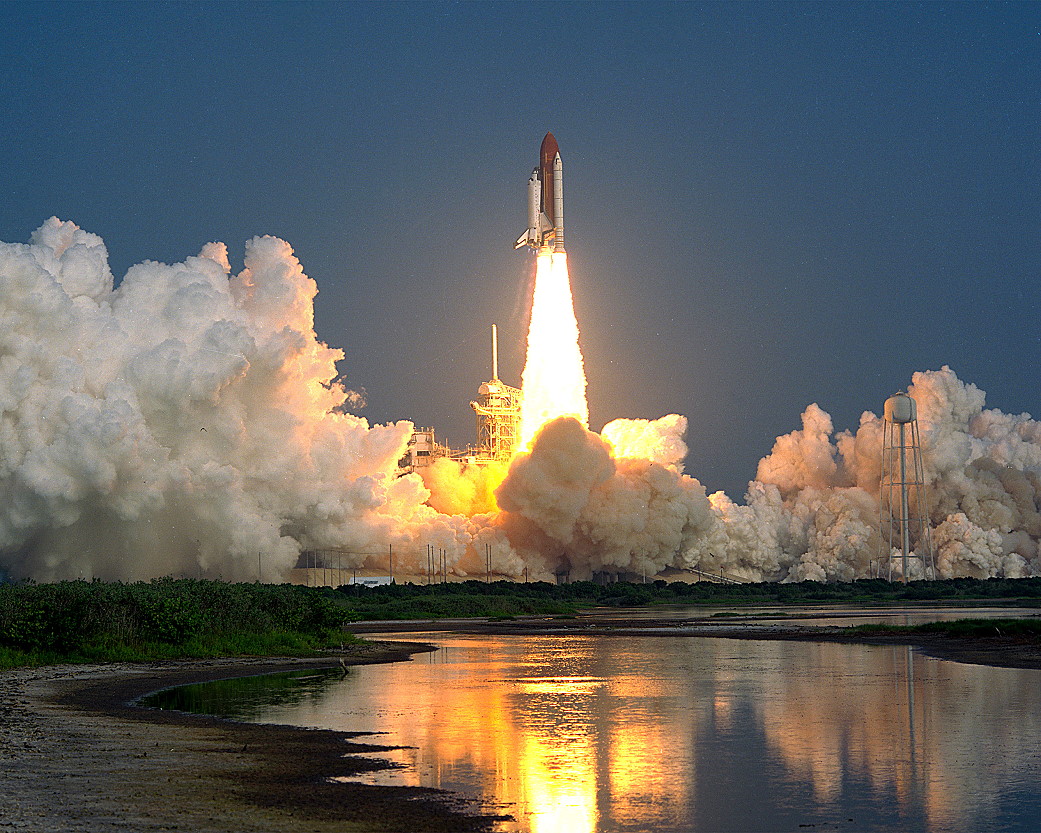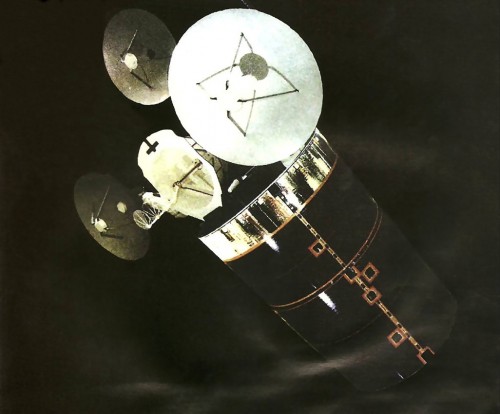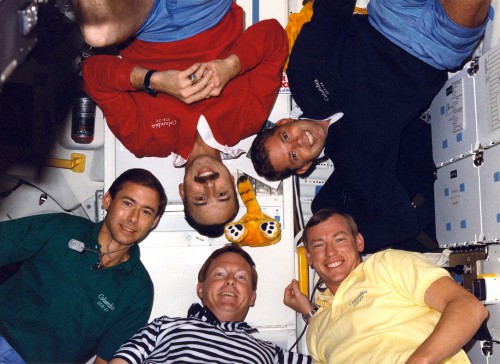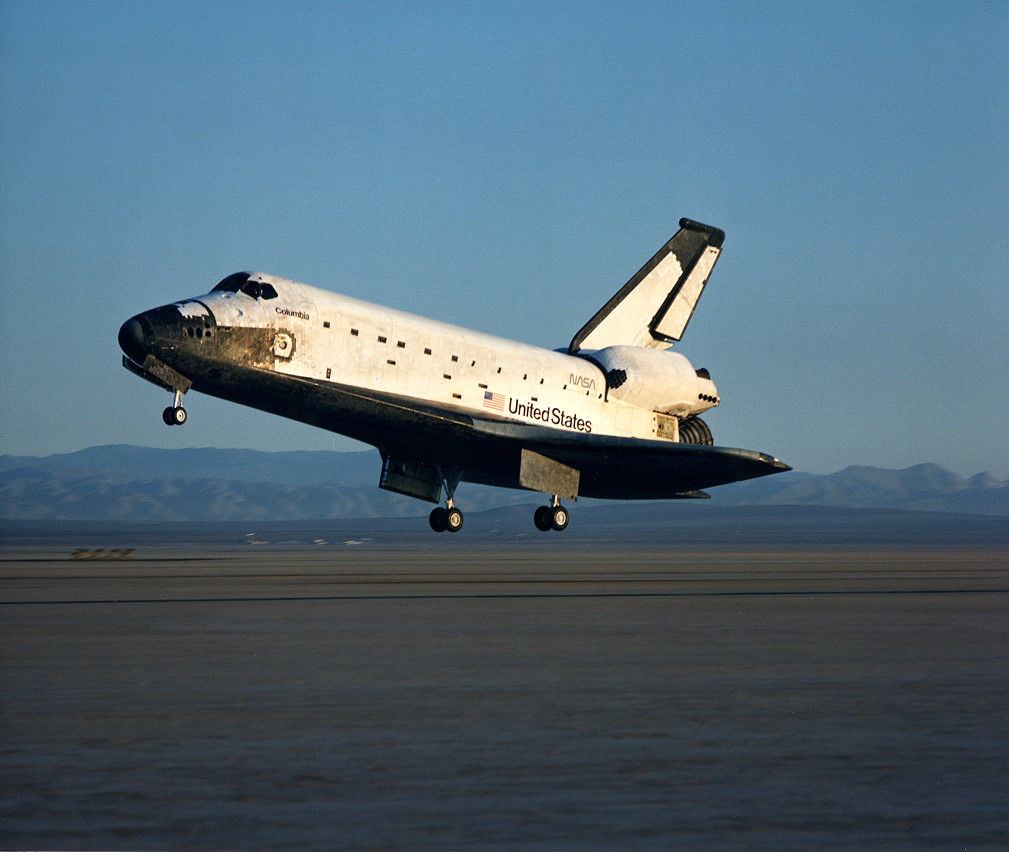
Twenty-five years ago, this week, the Shuttle Columbia returned to flight, following a three-year down time in the aftermath of the Challenger disaster. Aboard STS-28 for a five-day flight were Commander Brewster Shaw, Pilot Dick Richards, and Mission Specialists Jim Adamson, Dave Leestma—who retired from NASA earlier in 2014, after more than three decades of service—and Mark Brown, tasked with deploying a classified payload on behalf of the Department of Defense. In keeping with the mission, STS-28 was (and still is) largely shrouded in secrecy, and it was not for many years that a tiny chink opened to reveal a handful of sketchy details of what Shaw and his crew did in orbit.
As described in yesterday’s AmericaSpace’s history article, the relationship between NASA and the Department of Defense was a constrained one, particularly in view of the intense public attention which the shuttle attracted. In the wake of the loss of Challenger, most classified payloads were transferred onto expendable boosters and only the handful which were too large, too heavy, or too awkward to reconfigure retained their places on the reusable orbiters. Following STS-28’s successful liftoff on 8 August 1989, its primary payload was deployed into space about 7.5 hours into the mission. At the time, John Pike, a space policy analyst for the Federation of American Scientists, speculated that this payload was a massive, 32,000-pound (14,500-kg) KH-12 satellite, one of the latest generation of “Key Hole” photographic reconnaissance platforms, whose ancestry stretched back to the 1960s. Pike commented that the KH-12 was one of the Pentagon’s most expensive payloads—with an estimated price tag in the region of $1 billion, per unit—although other sources argued that STS-28’s cargo might have been a lighter Strategic Reconnaissance Satellite (SRS). Still others speculated that it was capable of maneuvering itself to an orbital altitude of around 300 miles (480 km), from which vantage point it could take photographs with a resolution as fine as 3.3 feet (1 meter).
More recently, it has come to light that the payload was probably a member of the second-generation Satellite Data System (SDS-B), a family of U.S. Air Force telecommunications platforms. In fact, doubts over whether it was a KH-12 were raised within weeks of the launch, when ground-based observers noted that the satellite “flashed,” as sunlight reflected from its solar panels, at regular intervals. This phenomenon, they concluded, was not normally consistent with a reconnaissance system. Certainly, it was not deployed by the shuttle’s Canadian-built Remote Manipulator System (RMS) mechanical arm, which was not carried on STS-28, and the first photographs of an SDS-B entered the public arena in the spring of 1998, when the National Reconnaissance Office (NRO) released images and videotapes of a pair of military satellites. One was identified as an SDS-B, and Hughes was acknowledged as its prime contractor. Physically, it was not dissimilar to the Syncom/Leasat payloads already deployed on earlier shuttle flights, but somewhat longer. In a 2009 article for Air & Space magazine, Michael Cassutt quoted an Air Force officer who was familiar with the SDS-B project. “It’s strange,” the officer told Cassutt, “to work on a secret project for ten years, then see it on network television!”

The Air Force began to develop the first-generation SDS in 1973 to provide America’s intelligence community with a network of orbiting relays, capable of transmitting real-time data and images from reconnaissance satellites which were out of range of ground stations. Another of their responsibilities was to support voice and data communications for covert military activities. The second-generation SDS-B—which first flew on STS-28—operated in high-apogee and low-perigee orbits, ranging from as close as 300 miles (480 km) and as far as 23,600 miles (38,000 km), at steep inclinations which achieved their highest point over the northern hemisphere. This enabled them to cover two-thirds of the globe, relay spy satellite data of the entire Soviet land mass, and cover the entire north polar region in support of Air Force communications. Such wide coverage was not possible to geostationary-orbiting satellites. The SDS-B featured a pair of 14.7-foot-diameter (4.5-meter) dish antennas and a third, smaller dish for Ku-band downlink. Overall, the satellite measured 13 feet (4 meters) long and 10 feet (3 meters) wide, with a launch mass estimated at close to 6,600 pounds (3,000 kg). In total, three of these cylindrical SDS-Bs were deployed by the shuttle, on STS-28, STS-38 in November 1990, and STS-53 in December 1992.
Although it is unclear as to how they were deployed, some observers have assumed that they were released in a similar fashion to the Syncoms, in a “frisbee” fashion. Others have noted that the solid-fueled rocket booster used for the SDS-B was an Orbus-21, physically identical to the motor later fitted to Intelsat 6-3 by spacewalking astronauts during STS-49 in May 1992. This has prompted alternative suggestions that the SDS-B was deployed “vertically” from a special cradle in the payload bay.
In whatever manner that SDS-B left Columbia, it is certain that the deployment was completed on the first day of the mission, because Shaw and Richards performed a separation manoeuvre at 4:58 p.m. EDT on 8 August 1989. A second payload, weighing just 275 pounds (125 kg), was also deployed and has been rumored to have been a kind of “ferret” satellite for radio and radar signals intelligence. The remainder of the mission went like clockwork, and the astronauts tended a number of military experiments in the middeck and a pair of Getaway Special (GAS) canisters in the payload bay.

After 18 months training together, the men of STS-28 had developed into a close-knit team … despite being in different branches of the military. Richards and Leestma were U.S. Navy, Shaw and Brown were Air Force, and Adamson was the only Army member of the crew, but their common string was that they all shared a military background. “We were all cut from the same cloth,” Richards remembered. “There wasn’t too much that we needed to talk about. We all understood each other and so, from that sense, it was probably boring to the outsiders, but it was comfortable for us.” Maintaining the requirements of the top-secret classification was a pain, although there were a handful of non-classified experiments … including an instrumental female skull, donated to research the penetration of radiation into the human cranium whilst in space. Hundreds of thermoluminescent dosimeters were mounted in the skull to record radiation levels, and it was flown twice more to measure the effects of different orbital altitudes and inclinations.
Five days after launch, at 6:37:08 a.m. PDT on 13 August, Brewster Shaw guided Columbia smoothly onto the dry lakebed Runway 17 at Edwards Air Force Base, Calif. “Super team and great machine,” radioed Capcom Frank Culbertson as the vehicle rolled to a halt. Shaw, however, was not happy with his landing. On his last flight, Mission 61B in November-December 1985, he had touched down on the concrete Runway 22, which, with its well-defined boundaries, made it easier to judge sink rates and heights. On the dry lakebed, there were stripes to outline the runway, but it was not nearly as well defined and affected his depth perception. “When we came down and I flared the orbiter,” he said, “I didn’t know how high we were. Looking at the photographs, we weren’t very high, but I basically leveled the vehicle off and then it floated.”
The result was that Shaw allowed Columbia to “float” on her main gear for a substantial portion of her deceleration, before rotating the nose gear down onto the runway. “We got a lot of great data about low-speed flying qualities on the orbiter,” he continued, “but it wasn’t supposed to work out that way.” Still, as Johnson Space Center (JSC) Director Aaron Cohen remarked as he greeted the five astronauts, the effort to get Columbia flying again had been triumphantly achieved. She looked pretty dirty, to be fair, after her eighth voyage, but had suffered minimal damage and almost immediately began preparations for her next flight in December 1989.

For Dick Richards, one other anecdote stood out from the STS-28 re-entry. As Columbia passed through Mach 10—about 7,600 mph (12,250 km/h)—and super-heated air streamed across the vehicle, creating and depositing pockets and blobs of white-hot plasma, something splattered across one of his cockpit windows … and stayed there. After touchdown, he mentioned it to Don Puddy, the head of the Flight Crew Operations Directorate (FCOD), and asked him to get one of the technicians to take a look at it. The substance, still in liquid form, was scooped up into a plastic coffee cup and taken away for analysis. That analysis was not quite what either man expected. A few days later, Richards caught up with Puddy.
“What did they say about what that material was?”
“You’re not gonna believe this,” Puddy replied with a grin and recounted the story. The technician had taken the coffee cup, filled with something from the upper reaches of the atmosphere, and placed it onto a counter. Without realizing, another technician had come along, grabbed the cup, poured coffee into it, and knocked it straight back.
“That,” he said in disgust, “is the worst tasting coffee I’ve ever had!”
From that day to this, Richards never discovered what had deposited itself on his cockpit window at 10 times the speed of sound … but, in a new and somewhat dubious space “first,” someone had at least tasted it.
This is part of a series of history articles, which will appear each weekend, barring any major news stories. Next week’s article will focus on the 25th anniversary of the historic Voyager-2 encounter with Neptune, bringing human eyes their first close-up glimpse of the distant planet.
Want to keep up-to-date with all things space? Be sure to “Like” AmericaSpace on Facebook and follow us on Twitter: @AmericaSpace




Interesting article,enjoyed it very much!
Regarding the Coffee,I have had comments about my coffee in the past,which hasn’t had “extra something ” in it!